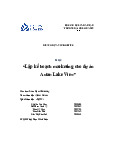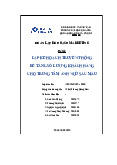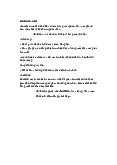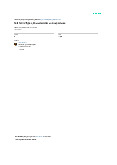



Preview text:
CHANGE LEADERSHIP WHY CHANGE
“Lego almost lost itself. The brand is no longer as strong as before, no one
knows what the company's vision and mission really are. ” - Jorgen Vig Knudstorp
“Lego gradually lost its essence, they started making watches, clothing,
movies, publishing books, and opening the Legoland Amusement Park ... The
Lego Group expanded into a range of industries they didn't have. a little bit of
experience, all because of the desire to increase market share and secure the
No. 1 position in the toy market. " - Anne-Valerie Ohlsson-Corboz
In 1998 Lego started to experience losses. In 2003, sales decreased by
26% and in 2004 decreased by 20%. These are the two biggest losses in Lego history.
Plougmann's strategy is to focus on entirely new products, make high-
tech toys and imitate trendy products that make Lego even more lagging.
Plougmann's misguided strategic directions, the unfavorable international
business environment and the fierce competition in the toy market made Lego even more crumbling.
The Legoland Game Park started to grow everywhere, "burning" a huge
amount of money in the group's budget.
Lego on the top of his life mistakenly developed and succeeded, the Lego
brand encroached on it so much that it pushed itself to the brink of bankruptcy.
Falling revenue, shrinking market share and layoffs are inevitable
consequences for Lego. Poul Plougmann himself had to admit that the state of
Lego "grew closer and closer to disaster". WHAT TO CHANGE
In 2003, Lego with an insolvency debt of more than $ 800 million gave
Knudstorp the opportunity to risk presenting all the data he had gathered to the
board, forecasting that the Lego Group would face bankruptcy. if not changed immediately.
Poul Plougmann was fired and replaced by Jorgen Vig Knudstorp, then
35 years old, had just worked for Lego for three years and was in charge of
finance of the corporation. He was also nominated by the board to become CEO
in 2004, with the main task of reviving a toy corporation that is losing nearly $ 1 million a day. HOW TO CHANGE
Therefore, the first and most important decision of Knudstorp is to give
up on new products and return to traditional products, with distinctive brand
identity. That is Lego's core business.
All non-Lego businesses that don't make a profit are dropped: Legoland,
clothing, video games. Lego sells entire stakes in non-key projects, including
numerous Legoland theme parks and dozens of other projects in the US, Australia and South Korea.
Manufacturing in the 1990s, with Lego having more than 14,000 different
pieces at huge production costs, Knudstorp came up with a series of solutions to
cut the number of pieces down to just 5,000 pieces.
Lego decided to only deliver to customers once a week and required pre-
orders after interviewing the top 20 customers (accounting for 70% of sales). As
a result, the rate of on-time delivery increased sharply from 62% (2005) to 92% (2008).
Lego went from bankrupt to profitable, and, more impressively, Lego
sales skyrocketed to more than $ 7.23 billion in 2015. Lego also managed to get
a boost. Honored as the most valuable brand in the world at the time.
Lego confidently produces over 36 billion puzzle pieces per year, and
during key sales seasons like Christmas, 28 Lego sets are sold in… per second!
Under Knudstorp's tenure, the LEGO Group's annual income went from
loss to substantial profit, and revenue increased 600% from 6.3 billion to 37.9
billion in 2016. In December 2016 , it was announced that Knudstorp will
resign as CEO of LEGO and instead take over as president of the group
KURT LEWIN'S CHANGE MODEL
Lego cannot apply Lewin's Model Change. Because Lego had so many
modifications and those changes left it on the brink of bankruptcy. The shifting
of Lego goals into areas where Lego had no experience was change failure.
When Lego returned to its original form, the company revived and continued to grow.
According to the individual opinion of our group. Lego needs more careful
alterations and shifts within safety. They should only focus on puzzles instead of Legoland
https://eduviet.vn/tin-tuc/bi-doa-anh-sap-bi-duoi-viec-van-kien-gan-
thuyet-phuc-ban-quan-tri-dai-tu-cong-ty-mot-nhan-vien-quen-duoc-bo-nhiem-
ceo-va-dua-lego-thoat-khoi-vuc-pha-san-day-ngoan-muc.html
https://doanhnhansaigon.vn/goc-nha-quan-tri/lego-bai-hoc-cho-su-hoi- sinh-1044508.html
https://baodautu.vn/chuyen-ve-jorgen-vig-knudstorp-ceo-cua-de-che-lego- d33374.html
https://www.pace.edu.vn/so-tay-doanh-tri/ChiTiet/1352/lego-va-cau-
chuyen-hoi-sinh-nho-quan-tri-san-xuat-tot/31
https://en.wikipedia.org/wiki/Jørgen_Vig_Knudstorp




